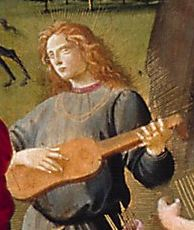Apollo playing the vihuela at the marriage of Thetis and and Peleus (c.1490-1501)
(1490-1501) - Paris, Musée du Louvre.
instrument: vihuela de mano | century: 15cent/3/late | catalogue nº: 15-345

Artwork
Creator di Giovanni, Bartolomeo
Medium Artwork: Painting
Location
City Florence | Region Italy | Old kingdom Florence
Characteristics
| Body Waisted | Strings Unclear | Neck Long | Pegbox R/Angled flat |
| Bridge Fixed | Frets Yes | Back Flat | Pegs Lateral |
| Technique Plucked fingers thumb in |
Commentary
ARTWORK
Les Noces de Thétis et Pelée [The marriage of Thetis and Peleus] (c.1490-1501) [R. F. 1346] is a painting by Bartolomeo di Giovanni, active in Florence 1488-1501, measuring 1505 x 425mm. The painting was originally a panel of a marriage chest, possibly together the Cortége de Thétis (R.F. 1347). The theme of the painting is the marriage of Thétis and Peleus at which Apollo accompanied them on the lyre. In front of him, the character Chiron plays a large lyre of classical shape.
INSTRUMENT
Shallow-bodied vihuela with a number of features that suggest that it might have been a monoxyl instrument. Note the way that the sound box and the neck are the same depth. The bridge is very close to the lower end of the instrument and the rosette is much closer to the fingerboard. This observation lead Carlos González (vihue-lista 28-12-2007) to speculate that the instrument is quite old. In point of fact its characteristics match the date of the painting. The pegbox is in the style of the lute, at right angles to the neck, and channelled with lateral pegs.
En guidobaldi2003, pp.202-203 (publicada por el CNRS), citan esta pintura y otras del mismo autor, dentro del proyecto de catalogación de pinturas con tema musical en el Museo del Louvre que esta revista dirigida por Florence Gétreau lleva a cabo desde hace años. El artículo dedicado a la pintura renacentista (IV de la serie) es obra de Nicoleta Guidobaldi. El tema es la boda de Tetis con Peleo, y aparece Apolo tocando la vihuela con los dedos y Quirón la lira con un gran plectro de tipo greco-latino, la caja de resonancia no es la tradicional tortuga, sino el cráneo de un astado cuyos cuernos son los brazos de la lira.
Lo que se aprecia bien es el clavijero en ángulo recto de tipo laúd.
Reproductions
http://cartelfr.louvre.fr/cartelfr/visite?srv=car_not_frame&idNotice=13695&langue=fr